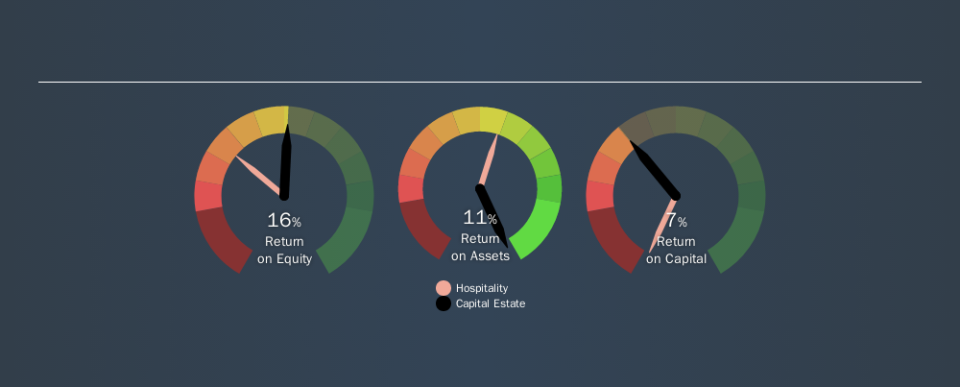Are Capital Estate Limited’s (HKG:193) High Returns Really That Great?

Today we'll evaluate Capital Estate Limited (HKG:193) to determine whether it could have potential as an investment idea. Specifically, we're going to calculate its Return On Capital Employed (ROCE), in the hopes of getting some insight into the business.
First up, we'll look at what ROCE is and how we calculate it. Second, we'll look at its ROCE compared to similar companies. And finally, we'll look at how its current liabilities are impacting its ROCE.
What is Return On Capital Employed (ROCE)?
ROCE is a measure of a company's yearly pre-tax profit (its return), relative to the capital employed in the business. Generally speaking a higher ROCE is better. Overall, it is a valuable metric that has its flaws. Author Edwin Whiting says to be careful when comparing the ROCE of different businesses, since 'No two businesses are exactly alike.
So, How Do We Calculate ROCE?
Analysts use this formula to calculate return on capital employed:
Return on Capital Employed = Earnings Before Interest and Tax (EBIT) ÷ (Total Assets - Current Liabilities)
Or for Capital Estate:
0.072 = HK$74m ÷ (HK$1.3b - HK$311m) (Based on the trailing twelve months to July 2019.)
Therefore, Capital Estate has an ROCE of 7.2%.
View our latest analysis for Capital Estate
Is Capital Estate's ROCE Good?
ROCE can be useful when making comparisons, such as between similar companies. In our analysis, Capital Estate's ROCE is meaningfully higher than the 5.0% average in the Hospitality industry. I think that's good to see, since it implies the company is better than other companies at making the most of its capital. Aside from the industry comparison, Capital Estate's ROCE is mediocre in absolute terms, considering the risk of investing in stocks versus the safety of a bank account. Investors may wish to consider higher-performing investments.
Capital Estate reported an ROCE of 7.2% -- better than 3 years ago, when the company didn't make a profit. That implies the business has been improving. You can click on the image below to see (in greater detail) how Capital Estate's past growth compares to other companies.
Remember that this metric is backwards looking - it shows what has happened in the past, and does not accurately predict the future. ROCE can be deceptive for cyclical businesses, as returns can look incredible in boom times, and terribly low in downturns. ROCE is only a point-in-time measure. You can check if Capital Estate has cyclical profits by looking at this free graph of past earnings, revenue and cash flow.
How Capital Estate's Current Liabilities Impact Its ROCE
Liabilities, such as supplier bills and bank overdrafts, are referred to as current liabilities if they need to be paid within 12 months. The ROCE equation subtracts current liabilities from capital employed, so a company with a lot of current liabilities appears to have less capital employed, and a higher ROCE than otherwise. To check the impact of this, we calculate if a company has high current liabilities relative to its total assets.
Capital Estate has total liabilities of HK$311m and total assets of HK$1.3b. Therefore its current liabilities are equivalent to approximately 23% of its total assets. This is a modest level of current liabilities, which would only have a small effect on ROCE.
What We Can Learn From Capital Estate's ROCE
That said, Capital Estate's ROCE is mediocre, there may be more attractive investments around. You might be able to find a better investment than Capital Estate. If you want a selection of possible winners, check out this free list of interesting companies that trade on a P/E below 20 (but have proven they can grow earnings).
For those who like to find winning investments this free list of growing companies with recent insider purchasing, could be just the ticket.
We aim to bring you long-term focused research analysis driven by fundamental data. Note that our analysis may not factor in the latest price-sensitive company announcements or qualitative material.
If you spot an error that warrants correction, please contact the editor at editorial-team@simplywallst.com. This article by Simply Wall St is general in nature. It does not constitute a recommendation to buy or sell any stock, and does not take account of your objectives, or your financial situation. Simply Wall St has no position in the stocks mentioned. Thank you for reading.

